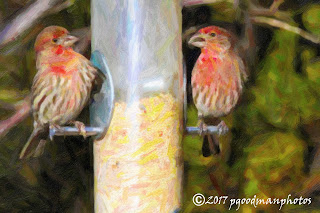 |
| The Discussion |
 |
| Black-throated sparrow |
This post assembles images shot out back of the house during the first
quarter of 2017. The opening image, shot the morning of 1 March, sure
seems to symbolize how we talk to each other these days. The
pyrrhuloxia is thoroughly sure of something -- but the smaller bird
seems distinctly unconvinced. Or maybe I've been paying too much
attention to politics of late.
We've lived in this
little house six years. Part of what we've loved about it is that it's
right
 |
| Curved-bill thrasher |
in the middle of desert life. The birds are a key part of that.
On too few mornings I take the time just to sit outside, drinking
coffee, watching and listening avidly, wondering if a poem will happen,
and/or trying to catch images like these of the birds going about
their mornings.
The birds vary in their shyness. Black-throated sparrows and some other sparrows are the boldest. They'll venture pretty close to us. After some disruption, they're the first to
return. Curved-bill thrashers are pretty bold, too. Then the house finches.
House finches are the most frequent sources of bright color this season, except when the pyrrhuloxia particularly the male) deigns to join the party. The male house finch is the redder.
 |
| Photographs from these mornings . . . |
 |
| . . . usually end up other sorts of images somehow |
The house finches are often together, like an old married couple chatting over their plans or memories, or whether or not last year's offspring will visit in the spring.
 |
| Pyrrhuloxia - or Desert Cardinal |
 |
| Note someone flying toward him at lower right |
 |
| This guy seems to be skipping down the branch |
 |
| Pyrrhuloxia on Ocotillo 927 |
 |
| The hummingbird deserves . . . |
 |
| . . . special photographic treatment |
The Sinister Stranger
It got suddenly silent. There were no birds. They'd already scattered once, when I came out to this wooden bench a half hour or so ago, but then they'd wandered back in and largely ignored me, though the pyrrhuloxia hadn't come in. So why? Then I spotted an eye shining in the shadows of a creosote bush. Larea. A hawk? I couldn't see much of the bird, but I stared at his eye and slowly brought the camera up to get a better look at him through the 600 mm. lens.
Yeah. Hawk. Smallish, but a hawk. Made sense. As I watched, we were both motionless, silent, alert. Each in our way hunting. Each a frightening apparition to the small birds, though I meant them no harm, but was just big and ungainly.
Something in the mood reminded me of a film noir in which a stranger in a black hat has just appeared on the street across from the protagonist's window. Or the heroine's. We haven't seen him arrive, he's just suddenly there, silent and sinister. Seemed there oughtta be a poem somewhere in there, in the moment and how it felt, but I had only a camera, no pen. As I watched longer, he did move to a slightly more exposed spot. After awhile he landed in the clearing between his post and mine, but before I could shoot a closer image of him he flew up and around the house.
He could have been a young Cooper's Hawk. They're here all year round, so we see a lot of 'em.
He also could be a Sharp-shinned Hawk. They're only here in winter, but winter it is. They're also a bit smaller than Cooper's. Both have yellow claws and eyes, and the brown lines on the belly and chest; but on the Cooper's those lines are longer and thinner, while the lines are browner and thicker on the sharp-shinned. Given that when I first saw him I wasn't even sure he was large enough to be a hawk, and that the Cooper's are very slender, I leaned toward the idea he was a sharp-shinned; and the lines aren't so long and thin. Too, Sibley said the sharp-shinned "often hunts around houses and birdfeeders; hunts from concealed perch or low, patrolling flight; captures small birds by surprise." He'd been well-concealed with ten meters of some bird-feeders.
























No comments:
Post a Comment